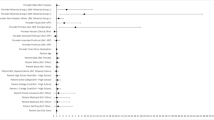Abstract
OBJECTIVE: To determine the frequency and determinants of provider nonrecognition of patients’ desires for specialist referral.
DESIGN: Prospective study.
SETTING: Internal medicine clinic in an academic medical center providing primary care to patients enrolled in a managed care plan.
PARTICIPANTS: Twelve faculty internists serving as primary care providers (PCPs) for 856 patient visits.
MEASUREMENTS AND MAIN RESULTS: Patients were given previsit and postvisit questionnaires asking about referral desire and visit satisfaction. Providers, blinded to patients’ referral desire, were asked after the visit whether a referral was discussed, who initiated the referral discussion, and whether the referral was indicated. Providers failed to discuss referral with 27% of patients who indicated a definite desire for referral and with 56% of patients, who indicated a possible desire for referral. There was significant variability in provider recognition of patient referral desire. Recognition is defined as the provider indicating that a referral was discussed when the patient marked a definite or possible desire for referral. Provider recognition improved significantly (P<.05), when the patient had more than one referral desire, if the patient or a family member was a health care worker and when the patient noted a definite desire versus a possible desire for referral. Patients were more likely (P<.05) to initiate a referral discussion when they had seen the PCP previously and had more than one referral desire. Of patient-initiated referral requests, 14% were considered “not indicated” by PCPs. Satisfaction with care did not differ in patients with a referral desire that were referred and those that were nor referred.
CONCLUSIONS: These PCPs frequently failed to explicitly recognize patients’ referral desires. Patients were more likely to initiate discussions of a referral desire when they saw their usual PCP and had more than a single referral desire.
Similar content being viewed by others
References
Franks P, Clancy CM, Nutting PA. Gatekeeping revisited-protecting patients from overtreatment. N Engl J Med. 1992;327:424–9.
Forrest CB, Starfield B. The effect of first-contact with primary care clinicians on ambulatory health expenditures. J Fam Pract. 1996;43:40–8.
Martin DP, Diehr P, Price KF, Richardson WC. Effect of a gatekeeper plan on health services use and charges: a randomized trial. Am J Public Health. 1989;79:1628–32.
Glenn JK, Lawler FK, Hoerl MS. Physician referrals in a competitive environment: an estimate of the economic impact of a referral. JAMA. 1987;258:1920–3.
Greenfield S, Nelson E, Zubkoff M. Variations in resource utilization among medical specialties and systems of care: results from the Medical Outcomes Study. JAMA. 1992;267:1624–30.
Donohoe MT. Comparing generalist and specialty care: discrepancies, deficiencies and excesses. Arch Intern Med. 1998;158:1596–608.
Webb S, Lloyd M. Prescribing and referral in general practice: a study of patients’ expectations and doctors’ actions. Br J Gen Pract. 1994;44:165–9.
Kravitz RL, Cope DW, Bhrany V, Leake B. Internal medicine patients’ expectations for care during office visits. J Gen Intern Med. 1994;9:75–81.
Hornberger J, Thom D, MaCurdy T. Effects of a self-administered pre-visit questionnaire to enhance awarencess of patients’ concerns in primary care. J Gen Intern Med. 1997;12:597–606.
Kravitz RL, Callahan EJ, Azari R, Antonius D, Lewis CE. Assessing patients’ expectations in ambulatory medical practice. J Gen Intern Med. 1997;12:67–72.
Marple RL, Kroenke K, Lucey CR, Wilder J, Lucas CA. Concerns and expectations in patients presenting with physical complaints. Arch Intern Med. 1997;157:1482–8.
Tabenkin H, Revital G, Brammli S, Shvartzman P. Views of direct access to specialists. JAMA. 1998;279:1943–8.
Rosenthal TC, Riemenschneider TA, Feather J. Preserving the patient referral process in the managed care environment. Am J Med. 1996;100:338–43.
Borowsky SJ. What do we really need to know about consultation and referral? J Gen Intern Med. 1998;13:497–8.
Kravitz RL, Callahan EJ, Paternitic D, Antonius D, Dunham M, Lewis CE. Prevalence and sources of patients’ unmet expectations for care. Ann Intern Med. 1996;125:730–7.
Kerr EA, Hays RD, Lee ML, Siu AL. Does dissatisfaction with access to specialists affect the desire to leave a health plan? J Gen Intern Med. 1996;11:77. Abstract.
Gallagher TH, Lo B, Chesney M, Christensen K. How do physicians respond to patients’ requests for costly, unindicated services? J Gen Intern Med. 1997;12:663–8.
Feldman DS, Novack DH, Gracely E. Effects of managed care on physician-patient relationships, quality of care and the ethical practice of medicine. Arch Intern Med. 1998;158:1626–32.
McLeod P, Tamblyn R, Gayton D, et al. Use of standardized patients to assess between physician variation in resource utilization. JAMA. 1997;278:1164–8.
Calman NS, Hyman RB, Hecht W. Variability in consultation rates and practitioner level of diagnostic certainty. J Fam Pract. 1992;35:31–8.
Franks P, Clancy CM. Referrals of adult patients from primary care: demographic disparities and their relationship to HMO insurance. J Fam Pract. 1997;45:47–53.
Albertson G, Lin CT, Swaney R, Anderson S, Anderson RJ. Patient-provider interactions in the subspecialty referral process in a gatekeeper model academic managed care plan. J Gen Intern Med. 1998;13(suppl):103. Abstract.
Author information
Authors and Affiliations
Corresponding author
Additional information
This work was funded by University Hospital Board of Directors, Denver, Colo.
Rights and permissions
About this article
Cite this article
Albertson, G.A., Lin, C.T., Kutner, J. et al. Recognition of patient referral desires in an academic managed care plan. J GEN INTERN MED 15, 242–247 (2000). https://doi.org/10.1111/j.1525-1497.2000.02208.x
Issue Date:
DOI: https://doi.org/10.1111/j.1525-1497.2000.02208.x



